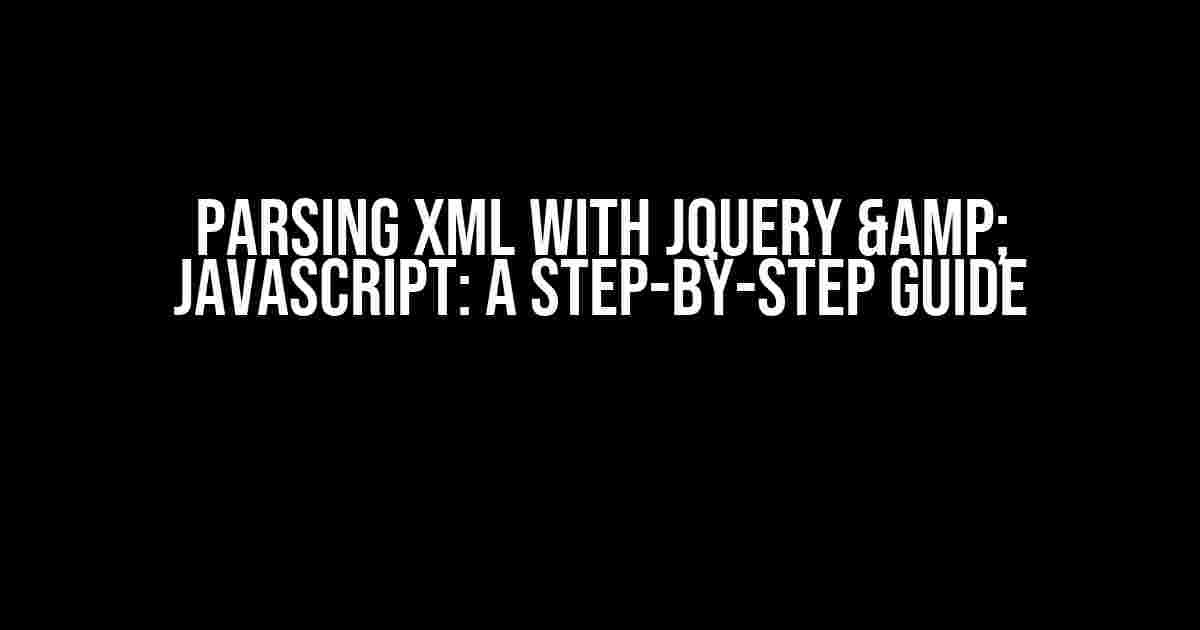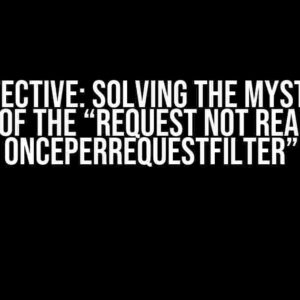In today’s digital landscape, data is king, and XML (Extensible Markup Language) is one of the most popular formats for storing and transporting data. But, have you ever wondered how to parse XML data using JQuery and Javascript? Look no further! In this comprehensive guide, we’ll take you on a journey to explore the world of XML parsing, covering the what, why, and how of it all.
What is XML and Why Do We Need to Parse It?
XML is a markup language that uses tags to define and structure data. It’s widely used in web services, APIs, and data storage to encode data in a format that’s both human-readable and machine-readable. However, XML data is not directly usable by most programming languages, including Javascript. That’s where parsing comes in – the process of breaking down XML data into a format that can be understood and utilized by our code.
Why Use JQuery and Javascript for XML Parsing?
Javascript is the de facto language of the web, and when combined with JQuery, it becomes an unstoppable force for XML parsing. Here are a few reasons why we’re focusing on this dynamic duo:
- Javascript is ubiquitous: It’s the most widely used programming language on the web, making it a natural choice for XML parsing.
- JQuery simplifies the process: With its powerful selectors and built-in methods, JQuery makes parsing XML a breeze.
- Client-side parsing: By parsing XML on the client-side, we can reduce the load on our servers and improve overall performance.
The Basics of XML Parsing with JQuery & Javascript
Before we dive into the code, let’s cover some fundamental concepts:
XML Structure: An XML document consists of elements (tags), attributes, and text nodes. Understanding this structure is crucial for effective parsing.
Javascript’s XMLHttpRequest: This built-in object allows us to send HTTP requests and retrieve XML data from a server.
JQuery’s parseXML(): This method takes a string of XML data as an input and returns a JQuery object that can be traversed and manipulated.
A Simple XML Parsing Example
<?xml version="1.0" encoding="UTF-8"?>
<catalog>
<book id="bk101">
<author>John Smith</author>
<title>XML for Beginners</title>
<genre>Computer</genre>
<price>39.95</price>
<publish_date>2000-10-01</publish_date>
<description>An in-depth look at creating XML documents</description>
</book>
<book id="bk102">
<author>Jane Doe</author>
<title>XML Advanced</title>
<genre>Computer</genre>
<price>59.95</price>
<publish_date>2001-11-01</publish_date>
<description>A comprehensive guide to XML schema</description>
</book>
</catalog>In this example, we have a simple XML catalog containing two book elements. Each book has several child elements, including author, title, genre, price, publish_date, and description.
Parsing XML with JQuery & Javascript: The Code
Now that we’ve covered the basics, let’s write some code! We’ll use JQuery’s parseXML() method to parse our XML data and extract the book titles.
<script>
$(document).ready(function() {
var xml = '<?xml version="1.0" encoding="UTF-8"?><catalog><book id="bk101"><title>XML for Beginners</title></book><book id="bk102"><title>XML Advanced</title></book></catalog>';
var xmlDoc = $.parseXML(xml);
var $xml = $(xmlDoc);
$xml.find('book').each(function() {
var title = $(this).find('title').text();
console.log("Book Title: " + title);
});
});
</script>In this example, we first define our XML data as a string. We then use JQuery’s parseXML() method to parse the XML data and create a JQuery object. Finally, we use the find() method to traverse the XML document and extract the book titles, logging them to the console.
Handling XML Attributes with JQuery & Javascript
In addition to parsing XML elements, we can also access and manipulate attributes using JQuery’s attr() method.
<script>
$(document).ready(function() {
var xml = '<?xml version="1.0" encoding="UTF-8"?><catalog><book id="bk101" genre="Computer"><title>XML for Beginners</title></book><book id="bk102" genre="Fiction"><title>XML Advanced</title></book></catalog>';
var xmlDoc = $.parseXML(xml);
var $xml = $(xmlDoc);
$xml.find('book').each(function() {
var id = $(this).attr('id');
var genre = $(this).attr('genre');
console.log("Book ID: " + id + ", Genre: " + genre);
});
});
</script>In this example, we use the attr() method to extract the id and genre attributes from each book element, logging them to the console.
Parsing XML with Namespaces using JQuery & Javascript
XML namespaces provide a way to avoid element name conflicts by associating elements with specific namespaces. Parsing XML with namespaces requires a slightly different approach.
<script>
$(document).ready(function() {
var xml = '<?xml version="1.0" encoding="UTF-8"?><x:catalog xmlns:x="http://example.com"><x:book x:genre="Computer"><x:title>XML for Beginners</x:title></x:book><x:book x:genre="Fiction"><x:title>XML Advanced</x:title></x:book></x:catalog>';
var xmlDoc = $.parseXML(xml);
var $xml = $(xmlDoc);
$xml.find('x\\:book').each(function() {
var genre = $(this).attr('x:genre');
console.log("Book Genre: " + genre);
});
});
</script>In this example, we use the find() method with a namespace-qualified selector (x\:book) to traverse the XML document and extract the genre attribute from each book element.
Common Issues and Troubleshooting Tips
When working with XML parsing, you may encounter some common issues:
- Invalid XML syntax: Ensure that your XML data is well-formed and follows the XML specification.
- Use namespace-qualified selectors to avoid element name conflicts.
- Verify that your JQuery and Javascript code is correct and error-free.
Conclusion
In this comprehensive guide, we’ve covered the ins and outs of parsing XML with JQuery and Javascript. From understanding XML structure to handling attributes and namespaces, you now possess the knowledge to tackle even the most complex XML parsing tasks. Remember to troubleshoot common issues and stay vigilant when working with XML data.
So, what’s next? Start exploring the world of XML parsing and uncover the secrets hidden within your data. Happy coding!
Here is the FAQs about Parsing XML with JQuery & Javascript:
Frequently Asked Question
Get ready to unleash the power of XML parsing with JQuery and Javascript! Below are some frequently asked questions to get you started.
What is XML parsing and why do I need it?
XML parsing is the process of analyzing and breaking down XML data into a format that can be easily read and utilized by programming languages like Javascript. You need XML parsing because it allows you to extract useful data from XML files, making it possible to create dynamic web pages, display data in a readable format, and even integrate with other systems. Trust us, it’s a game-changer!
Can I parse XML with just Javascript?
Yes, you can parse XML with just Javascript using the DOMParser API or XMLDOM objects. However, using JQuery can simplify the process and make it more efficient. JQuery provides a range of methods and selectors that make it easy to traverse and manipulate the XML data, making it a popular choice among developers.
How do I parse XML with JQuery?
To parse XML with JQuery, you can use the $.parseXML() method, which takes a string of XML data as an argument and returns an XML document object. From there, you can use JQuery methods like $(xml).find() or $(xml).filter() to traverse and manipulate the XML data.
What kind of errors might I encounter when parsing XML?
When parsing XML, you might encounter errors like XML syntax errors, namespace issues, or character encoding problems. To avoid these errors, make sure your XML file is well-formatted, and you’re using the correct namespace and character encoding. You can also use debugging tools like console logs or error handlers to catch and resolve any issues that arise.
Are there any security concerns when parsing XML?
Yes, there are security concerns when parsing XML, such as XML injection attacks or exposure to sensitive data. To mitigate these risks, make sure to validate and sanitize your XML input, use secure parsing methods, and avoid processing untrusted XML data. By taking these precautions, you can ensure the security and integrity of your XML parsing operations.


